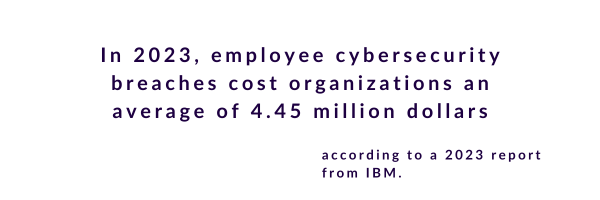What is employee cybersecurity? Plus, 3 ways to improve your cybersecurity strategy. Learn how organizations can improve employee cybersecurity practices through proactive training and hands-on education.
In 2023, employee cybersecurity breaches cost organizations an average of 4.45 million dollars, according to a 2023 report from IBM. What’s more, only 1 in 3 affected organizations were able to spot and report these breaches through internal security procedures. The rest had to be alerted of the breach by a third-party organization — or by the hackers themselves.
Remote work and the rise of AI technology have redefined our digital landscape. Without robust employee cybersecurity measures in place, companies of all sizes find themselves increasingly vulnerable to hackers or ransomware attacks.
Learn more about employee cybersecurity, including how a poor cybersecurity strategy could leave your organization vulnerable to attack.
What is employee cybersecurity? Why does employee cybersecurity matter?
Employees across all industries use some type of technology in their daily operations, from basic communications technology such as email and message systems to industry-specific technology such as medical devices or stock trading software.
Employee cybersecurity is the art of protecting these digital networks, devices, and data from unauthorized access or criminal use. Cyber security strategy may include protecting documents and emails from hackers, frequently checking for software viruses, reporting suspicious emails and more.
For many executive teams, employee cybersecurity is a top-of-mind issue. According to Accenture’s recent CEO survey, almost 3 in 4 CEOs worry about their company’s ability to minimize damage from a cybersecurity attack. And despite companies’ increasingly investing in cybersecurity software, these investments don’t address one of the greatest risks and vulnerabilities: employees, themselves.
Many cybersecurity attacks start with human error, whether it be accidentally downloading a virus or clicking on a phishing link. Employee cybersecurity ensures that workers have the right knowledge, strategy and preventative tools when it comes to spotting and averting cyber attacks.
3 ways to improve employee cybersecurity
1. Upgrade employee passwords with two-factor authentication.
Having a strong, unique password is helpful, but this is only the first layer of password protection. Passwords can be reused, stolen or cracked. So companies have started to double-check employees’ identity with two-factor authentication (also known as multi-factor authentication) as another layer of protection.
With two-factor authentication, after an employee inputs their password, they will be prompted to complete a second step that would be a lot harder for a hacker to fake. Common authentication methods, according to CISA, include using:
- Something an employee knows (e.g., a PIN or security question answer)
- Something an employee owns (e.g., sending a confirmation text to your phone)
- Something an employee is (e.g., fingerprint or face identification)
Adding an extra layer of protection can help prevent unauthorized access to accounts, software and other sensitive data.
2. Educate employees to spot (and avoid) phishing scams.
One of the most common ways that hackers target employees is through phishing scams, which involve the use of fraudulent emails, text messages, phone calls or websites designed to trick users into downloading malware, sharing sensitive or personal data (e.g., Social Security number, login credentials, etc.) and more.
According to IBM, over 40% of cybersecurity attacks use phishing to gain access to company information and data.
Phishing attacks commonly include grammatical and spelling errors, sketchy email addresses, threats of jail time and other unrealistic consequences. By teaching employees how to identify phishing, companies can minimize their vulnerability to hackers and ransomware attacks.
3. Create an online hub for employee cybersecurity resources.
To help employees navigate the ever-changing world of cybersecurity, companies have begun developing employee cybersecurity support hubs. Within these cybersecurity hubs, employees receive consistent reminders to perform software updates, regularly change their passwords and more.
Employee cybersecurity hubs serve as a dedicated resource for all things cybersecurity and IT-related. For instance, cybersecurity and IT hubs may include a hotline number for employees to call with any questions, as well as a reporting system for phishing attempts.
With a clear, consistent place for employees to get cybersecurity support, companies can help increase employees’ cybersecurity awareness and minimize the risk of a harmful breach.
To learn more about Best Money Moves Financial Wellness Platform, let’s schedule a call. Contact us and we’ll reach out to you soon.

